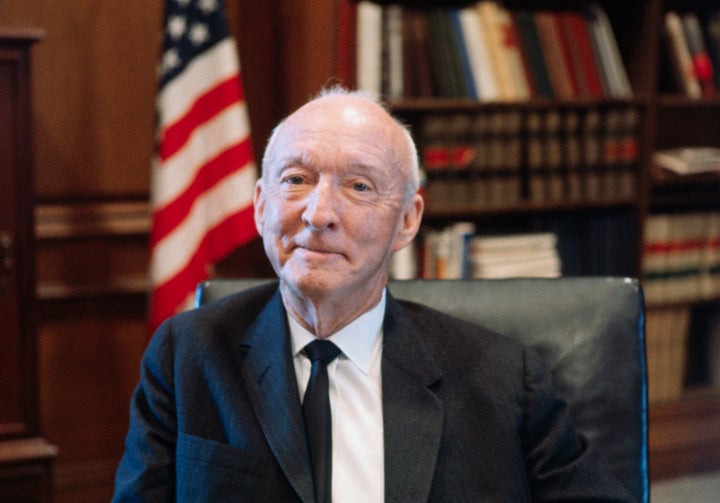
On August 11, 1921, Edwin Stephenson, a Methodist minister, shot and killed Father James Coyle on the rectory porch of St. Paul’s Catholic Church in Birmingham, Alabama. Earlier that day, Father Coyle had presided over the marriage of Stephenson’s eighteen-year-old daughter, Ruth, to native Puerto Rican Pedro Gussman, a 42-year-old wallpaper hanger. Independent-minded Ruth had been interested in Catholicism since adolescence; Coyle had baptized her into the Church some months before her marriage. When word of the wedding reached her father, he grabbed his gun and headed for St. Paul’s.
Because Father Coyle was unarmed, Stephenson’s defense team could not plausibly assert self-defense, and needed to come up with some other justification for his action. It did. Lead lawyer and future Supreme Court justice Hugo L. Black argued that Stephenson had acted in a state of temporary insanity brought on by the marriage of his daughter to a “negro.”
Pedro Gussman’s identity as a Negro came as news to him. Prior to the trial, he had always been regarded as white. He dated white women. He was registered to vote. Had Gussman been considered black, he and Ruth could not have acquired a marriage license, because marriage across the color line was strictly forbidden in Alabama. “No one has ever questioned my color until I became mixed up in this case,” he complained.
By transforming Pedro Gussman from a tanned Puerto Rican into a “negro,” Hugo Black offered the jury, composed exclusively of white men, a credible basis to find Edwin Stephenson temporarily insane. Father Coyle had seduced Ruth Stephenson away from the true faith and her father’s rightful rule, and had then married her to a man whose religion and color marked him as inferior. Any self-respecting white man would blow a fuse under such circumstances. The jury voted to acquit. Hugo Black’s reputation grew. He joined the local chapter of the Ku Klux Klan, which paid Stephenson’s legal fees.
Formally reconstituted at Stone Mountain, Georgia, in 1915 by white men inspired by the heroic portrayal of the Reconstruction-era Klan in the film Birth of a Nation, the Second Klan was not of the hooded-hicks-on-horseback variety. The resurgent KKK was strongest in the West and Midwest, and as common in urban as in rural areas. The 1920s Klan was rooted in WWI vigilance committees and is more accurately grouped with other postwar organizations like the American Legion than its Reconstruction antecedent. Two factors distinguished the resurgent Klan from other fraternal organizations of the era, however: its use of violence and its political influence.
This new version of the Klan participated actively in politics as voters, organizers, and candidates. Militantly Protestant, the Klan was a vehicle for “Old Stock” Americans (those whose ancestors had arrived before the great waves of immigration after 1890) striving to reassert cultural dominance over an increasingly heterogeneous and secular society. Klansmen lived in a fractured and disorienting world. Their country, especially its cities, was swamped with clannish Jews and Catholics, who educated their children apart and voted together. Their wives were politically enfranchised and assertive, their sons were disrespectful, and their daughters ungovernable, especially in matters of sex and marriage. Skeptics derided their religion. The economy, and thus their livelihood, was unpredictable.

At its peak in 1925, the Second Klan boasted a membership of more than 5 million, nearly all native white Protestants, many of whom were considered respectable members of their communities. The Klan’s causes — racial segregation, nativism, anti-communism, free enterprise, patriarchy, anti-Catholicism, anti-Semitism, Prohibition, and law and order — reflected its sense that everything was coming unglued.
The Second Klan was a national phenomenon. The Klan dominated politics in Texas, Indiana, Oklahoma, and Colorado, and was a significant political force in many cities, including Los Angeles, Chicago, Denver, Atlanta, and Dallas. Oregon elected a Klansman governor in 1922. Its state legislature, in a swipe at parochial schools, passed a bill mandating all children to attend public schools, where Protestantism and patriotism were taught together. Klansmen resisted African American “incursion” into white neighborhoods, and clamored for racial segregation in the North. A Klan write-in candidate for mayor of Detroit, a city with a large African American population and a hub of organized labor, attracted more than one-third of the vote in 1924. Klan-backed candidates were elected to the U. S. Senate in six states. Edwin Stephenson’s lawyer Hugo Black was one of them.
Although many Americans rolled their eyes at the spectacle of the Klan’s hooded marchers (40,000 strong outside the White House in 1926), the organization’s demand that control of the nation be returned to “old stock” Americans reflected widespread sentiment in the 1920s. Groups like the Anglo-Saxon League urged immigration restriction to limit the dilution of the Anglo-Saxon race by inferior Asian, African, and Eastern European bloodlines, arguing that “the idea of the great American melting pot, into which one can put the refuse of three continents and draw out good, sound American citizens... is simply and perilously false.”
Congress responded to calls to limit immigration and passed the National Origins Act of 1924, which set national immigration quotas for each country at two percent of its existing total U.S. population based on the 1890 census: the last count before the mass influx of immigrants from southern and eastern Europe. This change in immigration policy was designed to ensure that descendants of early immigrants would forever outnumber the children of the new. The new law barred the entry of anyone from Asia, which was defined expansively to include India. “America must be kept American,” new President Calvin Coolidge declared when signing the law. It was this law that Congress replaced when it passed the Immigration Act of 1965, and to which the Trump administration would happily revert.
After its national leader was convicted for murdering a white schoolteacher in 1925, the Second Klan declined. Membership in the Klan became a liability, particularly for politicians with national aspirations. In 1937, Franklin Roosevelt’s appointment of Hugo Black to the Supreme Court, where he became a stalwart liberal, was imperiled by his Klan background. In an 11-minute live radio address, Black apologized to Catholics but failed to mention African Americans or, indeed, Puerto Ricans.
The post-WWI Klan was defined by its opposition to immigration and cultural diversity, by its insistence on Protestant, Anglo-Saxon supremacy, and by its racism and reactionary gender politics. The khaki-clad young white men in Charlottesville chanting “blood and soil” and “Jew will not replace us” trace their ideological roots back to the Klan of the 1920s and call to mind a dark moment in our nation’s past. So does the particular disaffection of many of Donald Trump’s strongest supporters, who long to “make America great again” by constraining immigration and subordinating Muslims, African Americans, gays, women, and transgender persons. The fact that this movement is not unprecedented makes it no less troubling.
